A lump sum is a flat cash payment to cover relocation related expenses. These payments offer the flexibility to meet the needs of relocating employees while allowing employers to contain costs and simplify their mobility programs. There are two common methods for managing a lump sum:
- Lump sum only – The lump sum is the only relocation benefit offered to the employee
- Lump sum plus – A lump sum is offered along with additional managed services and/or reimbursed expenses (for example, a lump sum plus a household goods shipment)
Additionally, lump sums can be offered unmanaged (the full sum is disbursed at once) or managed (the employee can draw from an available sum or be reimbursed as expenses are incurred).
Aires’ recent pulse survey on U.S. domestic lump sum programs polled companies across all industries with a total of 62 companies responding.
Key findings of the survey include:
77% of respondents offer lump sum only packages to some or all of their employees.- Of these, an average of 45% of the company’s relocating population receive lump sum only benefits.
- The most common payment type is a static amount (such as $5,000 or $10,000). The next most common approach is paying a variable amount based on family size and move distance.
- These benefits are most commonly provided to employees classified as graduates, professionals, individual contributors, and managers.
- Of these, an average of 58% of the company’s relocating population receive lump sum plus benefits.
- The most common “plus” benefits offered are household goods/auto shipment, household goods storage, lease cancellation, home sale, and home purchase assistance.
More than 75% of respondents gross-up lump sum payments.
For a copy of the full Pulse Survey results, which provides additional details of each program, advantages and disadvantages of lump sum payments, and the projected future of lump sum benefits, please contact your Aires representative or click here.



